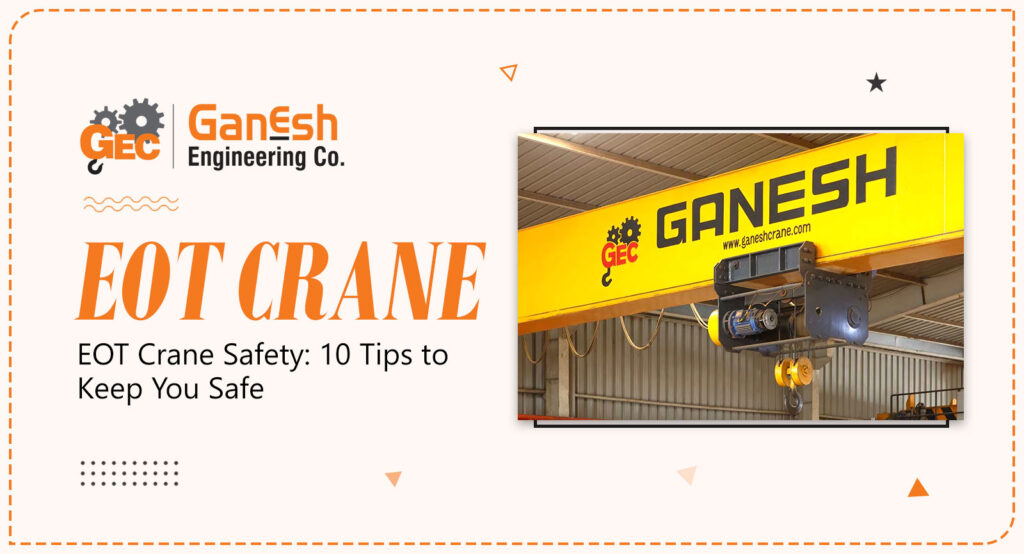
Overhead travelling EOT crane are essential pieces of equipment in many industries. They can be used to lift and move heavy objects, which can save time and labour costs. However, these cranes can also be dangerous if they are not operated safely under proper observation.
Why is Crane Safety Important?
Crane safety is crucial for several reasons, primarily centred around protecting the lives of workers and ensuring the proper functioning of construction and industrial operations. Cranes are powerful and complex machines used for lifting and moving heavy loads, and their operation involves significant risks. Here are some key reasons why crane safety is important:
Worker Safety:
The primary concern is the safety of the workers operating the crane, as well as those working in the vicinity. Crane accidents can lead to severe injuries or fatalities due to falls, equipment malfunctions, dropped loads, and collisions.Preventing Accidents:
Proper crane safety measures help prevent accidents, which can cause not only harm to individuals but also damage to property, equipment, and the environment. By following safety protocols, the likelihood of accidents is reduced.Legal and Regulatory Compliance:
Many countries have strict regulations and standards governing crane operation to ensure worker safety. Adhering to these regulations helps companies avoid legal penalties and fines.Risk Reduction:
A well-managed crane safety program reduces the overall risk associated with crane operations. This involves thorough risk assessments, safety training, and the use of appropriate safety equipment.Financial Impact:
Accidents involving cranes can result in significant financial losses for companies. Costs can include medical expenses, legal fees, property damage, equipment repair or replacement, and project delays.Project Delays:
Crane accidents can lead to project delays, which can have cascading effects on the entire construction or industrial project timeline. Delays can result in increased costs, missed deadlines, and client dissatisfaction.Reputation and Credibility:
A company’s commitment to crane safety reflects its overall dedication to worker well-being and professionalism. Failure to prioritize safety can damage a company’s reputation and credibility in the industry.Training and Education:
Ensuring crane safety requires comprehensive training for crane operators and other personnel involved in crane operations. Proper training enhances skills, awareness, and understanding of safe practices.Safe Work Environment:
Promoting crane safety contributes to the creation of a safer work environment overall. When workers feel secure and confident in their surroundings, they are more productive and engaged.Continuous Improvement:
Emphasizing crane safety encourages companies to continuously improve their safety protocols and procedures. Regular safety audits, incident analysis, and feedback mechanisms lead to safer practices over time.10 Safety Tips for Crane Operation
Here are 10 safety tips for crane operation:
Know the rated load of the crane.
Before you operate a crane, you need to know the rated load of the crane from the EOT Crane Suppliers in India. The rated load is the maximum weight that the crane can safely lift.
Never allow coworkers between fixed objects and load.
When lifting a load with a crane, never allow a coworker to stand between the fixed object and the load. This is because the load could swing and strike the coworker.
Don’t overload the crane or hoist.
Never overload a crane or hoist. Overloading can cause the crane to collapse, which can result in serious injuries or death.
Take instructions only from professionals.
When operating a crane, you should only take instructions from the person designated to give signals. This person is responsible for ensuring that the crane is operated safely.
Keep in mind the weather conditions.
Crane operations should be halted during adverse weather conditions such as high winds, storms, or heavy rainfall. Inclement weather can compromise the crane’s stability and make it difficult to handle loads safely.
Always position the lifting device directly over the load before lifting.
Before lifting a load, you should always position the lifting device directly over the load. This will help to ensure that the load is lifted safely.
Make sure that energy sources are isolated before initiating any maintenance activity.
Before performing any maintenance on a Single Girder EOT Crane, you should ensure that the energy sources are isolated.
This will help to prevent accidental contact with energised electrical lines.
Ensure that no one is present in pinch or crush zones.
Before lifting a load with a crane, you should ensure that everyone is clear of any pinch or crush zones.
This will help to prevent serious injuries if someone gets caught in a pinch point.
Keep an emergency plan ready.
The plan should outline procedures to follow in case of accidents, injuries, power failures, or equipment malfunctions.
Always maintain a clear view of the path.
When operating a crane, you should always maintain a clear view of the crane path. This will help you to avoid hitting any obstacles or personnel.
How to Prevent Accidents Involving Cranes?
In addition to following the safety tips listed above, you can also help to prevent accidents involving cranes by:
- Inspect the slings for any signs of wear and ensure proper rigging techniques are employed to prevent load shifting or slippage during lifting.
- Clear and effective communication between the crane operator and the workers on the ground is essential during crane operations.
- One of the most critical aspects of EOT Crane safety is ensuring that operators and personnel receive comprehensive training.
Conclusion
By following these tips you can significantly reduce the likelihood of accidents and ensure a safe working environment for everyone involved. Ganesh Engineering Co. is reputed to be one of the best EOT Crane Manufacturers in India with a huge collection of high-quality cranes. They have qualified experts who will provide you with thorough guidance as you choose the best crane for your requirements.

Ganesh Engineering
Ganesh Engineering Co. has been a leading manufacturer of Materials Handling Equipment in India since 2004. In order to provide top-notch products and services, our experienced and dedicated team utilizes the latest technology to achieve perfection.
